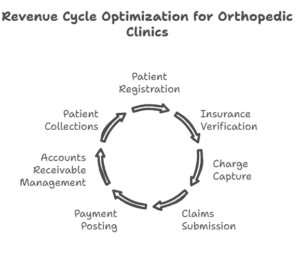Orthopedic clinics face unique challenges when it comes to managing their revenue cycle. The complexity of orthopedic services, which often involve surgeries, imaging, physical therapy, and long-term rehabilitation, requires efficient management to ensure timely reimbursements and minimize claim denials. Implementing best practices in revenue cycle management (RCM) can significantly improve financial performance, streamline operations, and enhance patient satisfaction.
In this article, we’ll explore the best practices for optimizing revenue cycle management in orthopedic clinics, from pre-authorization and coding accuracy to patient collections and claims follow-up.
Why Revenue Cycle Management is Crucial for Orthopedic Clinics
Orthopedic clinics handle a wide variety of procedures, including joint replacements, fractures, sports injuries, and physical therapy. With the high cost of orthopedic care and the complexity of insurance coverage for various services, optimizing the revenue cycle is essential for maintaining financial health. Inefficiencies in RCM can result in:
- Claim denials: Incorrect coding or missing information can lead to claim rejections, delaying payments.
- Delays in payment: Complex claims for surgical procedures or imaging often require longer processing times, and without proper follow-up, payment delays can occur.
- Patient dissatisfaction: Unexpected out-of-pocket costs or confusion about billing can lead to poor patient experiences.
Adopting RCM best practices can streamline billing processes, reduce errors, and ensure timely payment, improving both clinic profitability and patient care.
Revenue Cycle Best Practices for Orthopedic Clinics

1. Accurate Insurance Verification and Pre-Authorization
Before providing services, it’s important to verify the patient’s insurance coverage and obtain any necessary pre-authorization. This is especially critical for orthopedic procedures such as surgeries, joint replacements, and imaging. Best practices include:
- Verify coverage upfront: Ensure that the patient’s insurance plan covers the planned orthopedic procedures or services. Confirm the patient’s deductible, co-pays, and out-of-pocket responsibilities.
- Obtain pre-authorization: For complex procedures or surgeries, make sure pre-authorization is obtained from the insurance company. This reduces the risk of claim denials and ensures the patient’s insurance will cover the procedure.
- Document patient responsibilities: Clearly communicate the patient’s financial responsibilities, including co-pays and deductibles, before the procedure begins.
2. Correct Coding and Documentation
Accurate coding is essential for proper reimbursement in orthopedic care. Orthopedic procedures, especially surgeries and imaging, require precise documentation and correct application of coding standards. Key practices include:
- Use current coding systems: Ensure that all orthopedic procedures are coded using the latest ICD-10, CPT, and HCPCS codes.
- Properly document procedures: Document all procedures and treatments in detail, including any complications, follow-up visits, and necessary equipment, to avoid incorrect coding.
- Training and education: Regularly train coding and billing staff on the nuances of orthopedic coding to minimize errors and ensure accurate claims.
3. Streamlined Claims Submission
Timely and accurate claims submission is essential for maintaining cash flow in orthopedic clinics. Best practices for claims submission include:
- Submit claims promptly: Ensure claims are submitted as soon as possible after services are rendered, ideally within 24 to 48 hours of the appointment or procedure.
- Electronic submission: Use electronic claims submission to reduce errors and speed up processing times. This also provides tracking and reduces paperwork.
- Ensure accuracy: Double-check all claims for accuracy before submission, including verifying codes, insurance details, and patient information.
4. Efficient Claims Follow-Up and Denial Management
Claim denials are a common issue in orthopedic billing, especially for complex procedures. A systematic follow-up process is essential for reducing claim denials and ensuring timely payment. Key practices include:
- Follow up on unpaid claims: Regularly track the status of submitted claims and follow up on unpaid claims within a set timeframe, typically 30 to 45 days.
- Analyze denials: When claims are denied, investigate the cause of the denial and take corrective action. Common reasons for denials include coding errors, lack of pre-authorization, or incomplete documentation.
- Appeal denials promptly: If a claim is denied, submit an appeal with the correct information, including medical necessity documentation or additional details to support the claim.
5. Effective Patient Collections
Orthopedic procedures can be expensive, and patient collections are often a significant portion of an orthopedic clinic’s revenue. It’s essential to have clear and effective practices in place to collect patient payments. Best practices for patient collections include:
- Transparent billing: Ensure that patients understand their financial responsibility before receiving services. This can be achieved through detailed estimates and communication about co-pays, deductibles, and out-of-pocket costs.
- Payment plans: Offer flexible payment plans for patients who cannot afford to pay their balance in full. This makes it easier for patients to manage their financial responsibility and ensures the clinic receives payment over time.
- Online payment options: Provide convenient online payment portals for patients to pay their bills quickly and securely.
6. Optimize Use of Technology
Technology plays a crucial role in modernizing and streamlining the revenue cycle in orthopedic clinics. Key technologies include:
- RCM software: Use automated RCM software to streamline billing, coding, and claims submission processes. This can reduce errors and speed up reimbursement.
- Electronic health records (EHR): Use EHR systems to accurately document patient visits, procedures, and treatments. This can help ensure that coding is accurate and documentation is complete.
- Patient portals: Implement patient portals where patients can access their billing information, make payments, and communicate with the clinic’s billing department.
7. Regular Audits and Performance Monitoring
Regular audits and monitoring are critical for maintaining the effectiveness of the RCM process. Best practices for audits and monitoring include:
- Conduct regular audits: Periodically audit coding, billing, and claims submission processes to identify and correct any errors or inefficiencies.
- Track key performance indicators (KPIs): Monitor KPIs such as days in accounts receivable (A/R), first-pass claim resolution rates, and claim rejection rates to measure the success of RCM efforts and identify areas for improvement.
8. Staff Training and Communication
A well-trained staff is essential for the smooth operation of the revenue cycle in orthopedic clinics. Best practices for staff training and communication include:
- Ongoing education: Provide ongoing training for coding, billing, and front-office staff to ensure they are up to date with the latest regulations, coding standards, and payer requirements.
- Interdepartmental collaboration: Foster collaboration between clinical and administrative teams to ensure that all necessary information is captured accurately and efficiently, reducing errors in billing and coding.
Conclusion
Optimizing the revenue cycle in orthopedic clinics requires a combination of accurate insurance verification, correct coding, timely claims submission, and efficient patient collections. By implementing best practices such as improving coding accuracy, streamlining claims follow-up, and leveraging technology, orthopedic clinics can enhance their financial performance, reduce claim denials, and improve patient satisfaction. A well-managed revenue cycle not only supports the financial health of the clinic but also ensures that patients receive the care they need without unnecessary delays or financial confusion.
What People Are Asking
1. How can orthopedic clinics reduce claim denials?
By ensuring accurate coding, obtaining pre-authorization, and submitting claims promptly, orthopedic clinics can reduce claim denials and improve reimbursement rates.
2. What is the role of technology in orthopedic RCM?
Technology, including RCM software and EHR systems, helps streamline billing, coding, and claims submission, reducing errors and improving efficiency.
3. How can orthopedic clinics improve patient collections?
Offering transparent billing, providing payment plans, and using online payment options can help orthopedic clinics collect payments efficiently.
4. Why is financial clearance important for orthopedic clinics?
Financial clearance ensures that insurance coverage and patient financial responsibility are confirmed upfront, reducing the risk of denied claims and improving revenue cycle efficiency.
5. How often should orthopedic clinics perform audits on their RCM processes?
Orthopedic clinics should conduct regular audits to ensure that their RCM processes are accurate, efficient, and compliant with payer requirements. Auditing quarterly or semi-annually is recommended.
Disclaimer
For informational purposes only; not applicable to specific situations.
For tailored support and professional services,
please contact Staffingly, Inc. at (800) 489-5877
Email: support@staffingly.com.
About This Blog: This Blog is brought to you by Staffingly, Inc., a trusted name in healthcare outsourcing. The team of skilled healthcare specialists and content creators is dedicated to improving the quality and efficiency of healthcare services. The team passionate about sharing knowledge through insightful articles, blogs, and other educational resources.
 Book a Demo to Build Your Team Today!
Book a Demo to Build Your Team Today!

 Read Case Studies
Read Case Studies 


 Virtual Medical Assistants
Virtual Medical Assistants



